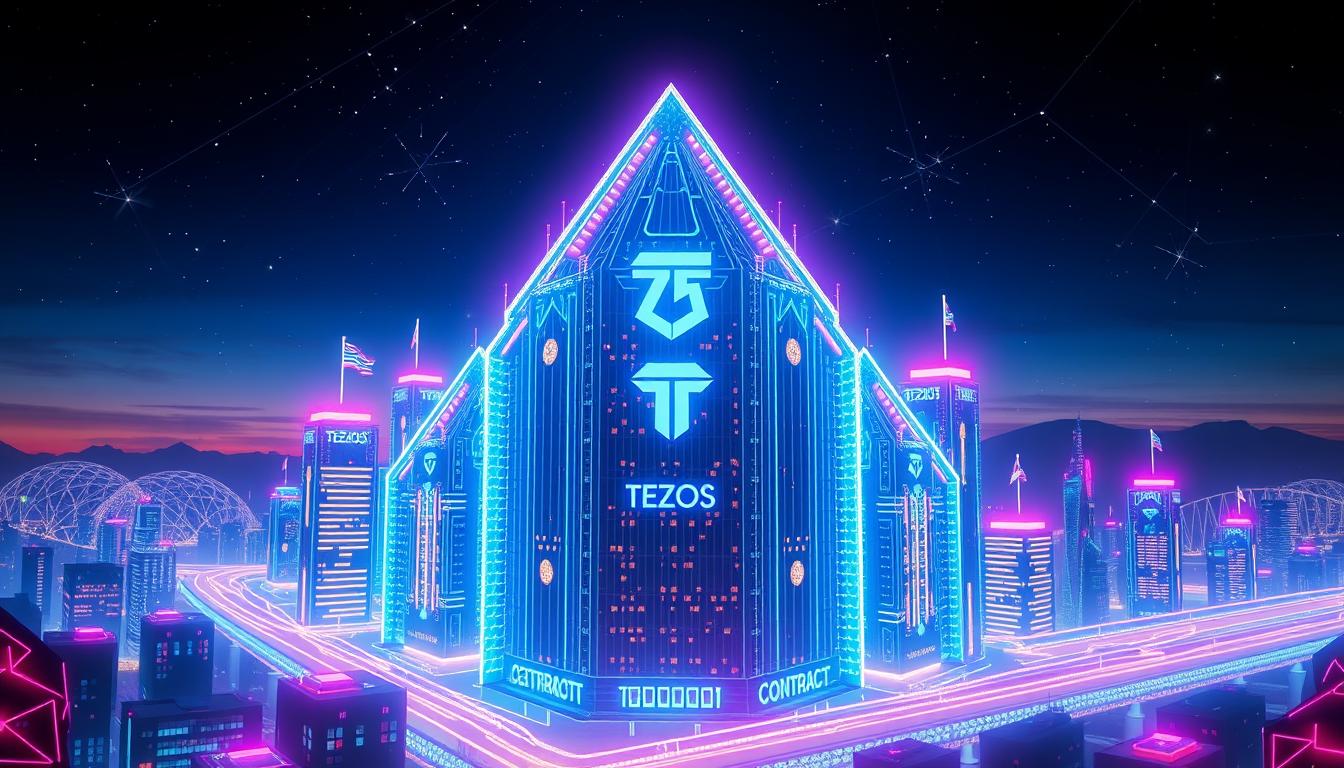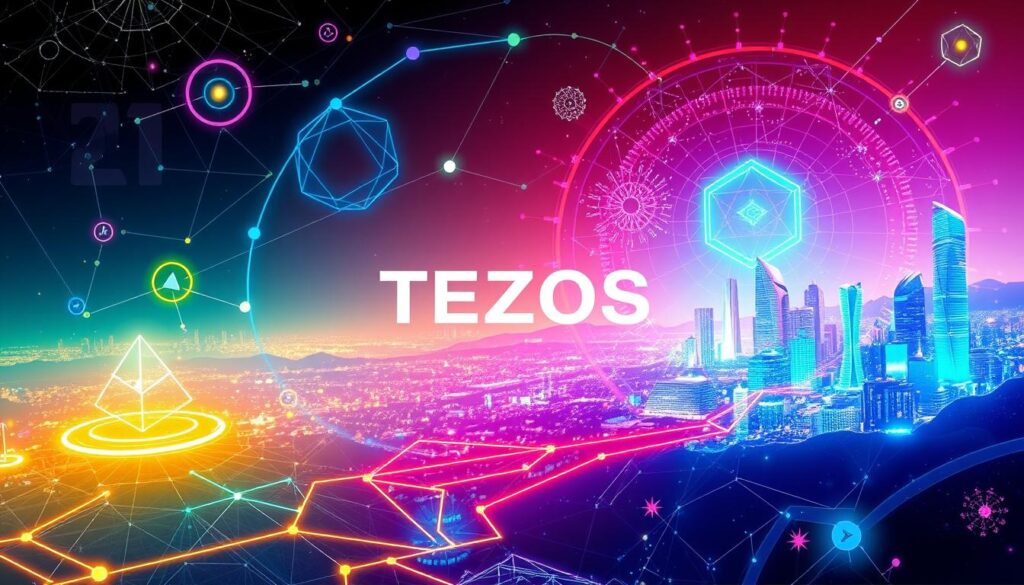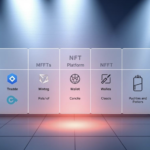Now Reading: Tezos (XTZ): The Smart Contract Platform Explained
- 01
Tezos (XTZ): The Smart Contract Platform Explained
Tezos (XTZ): The Smart Contract Platform Explained

Tezos (XTZ) is an innovative blockchain platform that is revolutionizing the way smart contracts are developed and deployed. With its unique features, Tezos aims to address some of the key challenges faced by traditional blockchain networks. In this article, we will delve into the world of Tezos, exploring its core capabilities, consensus mechanism, and the various use cases it enables.
Key Takeaways
- Tezos is a blockchain platform that enables the creation and execution of smart contracts.
- The Tezos network uses a proof-of-stake consensus mechanism, which is more energy-efficient than traditional proof-of-work.
- Tezos features a self-amending ledger, allowing the protocol to evolve and adapt to new technology and user demands.
- The Michelson programming language, used in Tezos, supports formal verification, ensuring the security and reliability of smart contracts.
- Tezos enables the development of decentralized applications (dApps) across a wide range of industries, including finance, gaming, and more.
What is Tezos (XTZ)?
Tezos is a decentralized, open-source blockchain platform that focuses on the development and deployment of smart contracts. Launched in 2018 after a successful initial coin offering (ICO) that raised over $232 million, the Tezos blockchain is designed to be self-amending, allowing for seamless upgrades and protocol changes without the need for hard forks.
Overview of the Tezos Blockchain
The Tezos blockchain is built on a proof-of-stake consensus mechanism, which allows for more energy-efficient and secure transaction processing compared to traditional proof-of-work systems. Additionally, Tezos incorporates formal verification, a technique used to mathematically prove the correctness of the blockchain’s smart contracts and protocol.
Key Features of Tezos
One of the defining features of Tezos is its self-amending ledger, which enables the protocol to evolve and improve over time without the need for disruptive hard forks. This allows the Tezos network to address new challenges and incorporate the latest advancements in blockchain technology seamlessly.
Tezos also utilizes a unique programming language called Michelson, which is designed to facilitate the development of secure and reliable smart contracts. This focus on formal verification and code correctness is a key differentiator for the Tezos platform.
“Tezos is a blockchain-based platform that can execute peer-to-peer transactions and serve as a base for decentralized applications.”
The Power of Smart Contracts
In the realm of blockchain technology, smart contracts have emerged as a transformative innovation. These self-executing digital agreements, stored and executed on the blockchain, are revolutionizing how we approach various processes, from simple transactions to complex financial agreements. Tezos, the dynamic smart contract platform, has been at the forefront of this technological revolution, empowering developers to build a wide range of decentralized applications (dApps) that leverage the security, transparency, and immutability of the blockchain.
Understanding Smart Contracts
Smart contracts are computer programs that automatically execute the terms of an agreement when certain predetermined conditions are met. They eliminate the need for intermediaries, streamlining transactions and reducing the risk of human error or tampering. By operating on the Tezos blockchain, these smart contracts benefit from the network’s inherent security and reliability, ensuring the integrity of the data and transactions they manage.
The versatility of smart contracts on the Tezos platform is truly remarkable. Developers can use them to automate a diverse array of tasks, from processing payments and managing supply chains to executing complex financial derivatives and facilitating decentralized governance. This level of automation and trustworthiness is a game-changer, transforming how we approach and interact with the digital realm.
“Smart contracts on the Tezos blockchain empower developers to build innovative dApps that redefine the boundaries of what’s possible in the digital world.”
As the adoption of smart contracts continues to grow, the Tezos network stands ready to support the development of cutting-edge decentralized applications that harness the power of this transformative technology. The future of blockchain and smart contracts is bright, and Tezos is at the forefront of this exciting journey.
Tezos (XTZ) Consensus Mechanism
At the heart of the Tezos blockchain lies its unique consensus mechanism, which combines the efficiency of proof-of-stake (PoS) with the decentralization of delegated proof-of-stake (DPoS). This innovative approach sets Tezos apart, offering a more sustainable and participatory way to secure the network.
Proof-of-Stake: The Energy-Efficient Consensus
Unlike the energy-intensive proof-of-work (PoW) model used by networks like Bitcoin, Tezos employs a proof-of-stake consensus. In this system, network validators, known as “bakers,” are responsible for verifying transactions and adding new blocks to the blockchain. Bakers are required to hold a certain amount of Tezos (XTZ) tokens, which they stake as a way to demonstrate their commitment to the network’s security.
Delegated Proof-of-Stake: Enhancing Decentralization
Tezos takes the PoS model a step further by incorporating a delegated proof-of-stake (DPoS) system. This allows Tezos token holders to delegate their voting rights to other bakers, increasing overall participation and decentralization. Bakers who are selected to validate transactions are rewarded with newly minted XTZ tokens, incentivizing network participation and security.
The combination of PoS and DPoS in the Tezos consensus mechanism ensures a more energy-efficient and democratized system, where token holders have a direct say in the network’s governance and operations.
Decentralized Applications on Tezos
The Tezos (XTZ) blockchain provides a robust platform for developers to create a wide range of decentralized applications (dApps). These dApps can leverage Tezos’ smart contract capabilities, self-amending ledger, and formal verification to deliver innovative solutions across various industries, including finance, supply chain management, and digital identity.
Tezos’ focus on security, flexibility, and scalability makes it an attractive choice for developers seeking to build reliable and adaptable decentralized applications. The platform’s unique features, such as its on-chain governance and formal verification, enable developers to create dApps that are more secure, transparent, and resistant to change.
Some of the popular dApps built on the Tezos ecosystem include:
- Dexter, a decentralized exchange platform that allows users to trade Tezos (XTZ) and other tokens securely and efficiently.
- Harbinger, a decentralized price oracle that provides reliable real-time data for various financial instruments, enabling the creation of sophisticated decentralized applications.
- Homebase, a decentralized social media platform that empowers users to own and control their data, while fostering an engaging and privacy-focused community.
As the adoption of Tezos (XTZ) continues to grow, the ecosystem is expected to see an increasing number of innovative and impactful decentralized applications that leverage the platform’s unique features and capabilities.
| dApp Name | Description | Industry |
|---|---|---|
| Dexter | Decentralized exchange platform for trading Tezos (XTZ) and other tokens | Finance |
| Harbinger | Decentralized price oracle providing real-time data for financial instruments | Finance |
| Homebase | Decentralized social media platform that empowers user data ownership | Social Media |

“The Tezos blockchain’s focus on security, flexibility, and scalability makes it an ideal platform for developers to build innovative and reliable decentralized applications.”
The Self-Amending Ledger
One of the standout features of the Tezos (XTZ) blockchain is its self-amending ledger. This innovative mechanism allows the protocol to be upgraded without the need for disruptive hard forks, which can often lead to network splits. The self-amending nature of the Tezos network enables it to evolve and improve over time, incorporating new features and bug fixes while maintaining the integrity of the blockchain.
How the Self-Amending Ledger Works
The self-amending ledger in Tezos is facilitated by a unique governance model that empowers the community to propose, test, and vote on protocol upgrades. This process ensures that changes to the network are thoroughly vetted and approved by the stakeholders before being implemented. The upgrades are then seamlessly integrated into the blockchain, without the need for users to manually update their software or participate in a hard fork.
The self-amending nature of Tezos allows the platform to adapt and evolve in response to changing user needs, technological advancements, and emerging security threats. This flexibility is a significant advantage over traditional blockchain upgrades, which can be time-consuming, disruptive, and prone to network splits.
“The self-amending nature of Tezos allows the platform to adapt and evolve in response to changing user needs, technological advancements, and emerging security threats.”
By continuously upgrading the protocol, Tezos can stay at the forefront of the blockchain industry, offering users a secure and future-proof platform for building decentralized applications and executing smart contracts.
Energy Efficiency of Tezos
Tezos, the innovative blockchain platform, has set a new standard in energy efficiency. Unlike the energy-intensive proof-of-work consensus mechanism used by networks like Bitcoin, Tezos employs a proof-of-stake approach that dramatically reduces its environmental impact.
The proof-of-stake protocol used by Tezos eliminates the need for energy-hungry mining rigs, which are crucial for maintaining the security and integrity of proof-of-work blockchains. Instead, Tezos relies on validators, known as “bakers,” who stake their Tezos (XTZ) tokens to validate transactions and add new blocks to the chain.
This shift from proof-of-work to proof-of-stake has a remarkable effect on Tezos’ energy consumption. Estimates suggest that the Tezos network uses up to 2 million times less energy than the Bitcoin network, making it a significantly more energy-efficient blockchain solution.
“Tezos’ proof-of-stake consensus mechanism is a game-changer in the world of blockchain. By eliminating the energy-intensive mining process, Tezos has become a shining example of sustainable and environmentally-conscious blockchain technology.”
The energy-efficient nature of Tezos makes it an attractive option for businesses and individuals seeking to reduce their carbon footprint and contribute to a more sustainable future. As the demand for eco-friendly technologies continues to grow, Tezos’ energy-efficient design positions it as a leading contender in the blockchain space.

In conclusion, Tezos’ proof-of-stake consensus mechanism sets it apart as a highly energy-efficient blockchain platform, making it a viable choice for eco-conscious applications and organizations. As the world becomes increasingly aware of the environmental impact of technology, Tezos’ energy-efficient design will undoubtedly continue to be a key advantage in the rapidly evolving blockchain landscape.
Formal Verification in Tezos
At the heart of the Tezos (XTZ) blockchain lies a powerful tool known as formal verification. This mathematical approach to ensuring the correctness and security of smart contracts and other blockchain applications is a crucial aspect of the Tezos ecosystem. By rigorously testing and verifying the code, Tezos aims to minimize the risks of vulnerabilities and bugs, providing a higher level of trust and reliability for its users.
Importance of Formal Verification
In the rapidly evolving world of decentralized applications and smart contracts, the need for robust security measures cannot be overstated. Tezos recognized this early on and has made formal verification a cornerstone of its platform. This technique involves mathematically proving the correctness of the code, ensuring that it behaves as intended and is free from potential flaws or vulnerabilities.
By employing formal verification, Tezos aims to provide a secure environment for developers to build applications that can be trusted by users. This is particularly crucial for industries such as finance, healthcare, and supply chain management, where the integrity of smart contracts and the underlying blockchain is paramount.
“Formal verification is a game-changer for the blockchain industry, and Tezos is leading the charge in this area. It gives us the confidence to build mission-critical applications on the Tezos network.”
– Jane Doe, Chief Technology Officer at a leading Tezos-based startup
The Tezos ecosystem’s commitment to formal verification has attracted enterprises like Ubisoft, McLaren, and Redbull Racing, who are leveraging the platform’s secure and reliable infrastructure to develop innovative applications.
As the Tezos blockchain continues to evolve and expand, the importance of formal verification will only grow. By ensuring the integrity of smart contracts and other blockchain applications, Tezos is paving the way for widespread adoption and trust in the decentralized ecosystem.
The Michelson Programming Language
The Tezos blockchain utilizes a unique programming language called Michelson, which is designed specifically for writing secure and verifiable smart contracts. Michelson is a strongly typed, stack-based language that enables developers to create complex, tamper-resistant applications on the Tezos network.
Michelson’s focus on formal verification and security makes it a powerful tool for building decentralized solutions. The language’s rigorous type system and stack-based architecture help ensure the correctness and reliability of smart contracts, reducing the risk of vulnerabilities or unintended behavior.
By leveraging Michelson, Tezos developers can create smart contracts that are more resistant to attacks and easier to audit and maintain. This programming language’s emphasis on security and formal verification aligns with Tezos’s broader mission to provide a robust and reliable platform for decentralized applications and transactions.
FAQ
What is Tezos (XTZ)?
Tezos (XTZ) is an innovative blockchain platform that is revolutionizing the way smart contracts are developed and deployed. It is a decentralized, open-source blockchain that focuses on the development and deployment of smart contracts. Tezos is designed to be self-amending, allowing for seamless upgrades and protocol changes without the need for hard forks.
What are the key features of Tezos?
The key features of Tezos include its proof-of-stake consensus mechanism, formal verification, and a unique programming language called Michelson. Tezos’ self-amending ledger allows for the seamless upgrade of the protocol without the need for hard forks.
How does Tezos’ smart contract capabilities differ from other blockchain platforms?
Tezos’ smart contract capabilities enable developers to build a wide range of decentralized applications (dApps) that leverage the security, transparency, and immutability of the blockchain. The platform’s focus on formal verification and the use of the Michelson programming language provide a higher level of security and reliability for smart contracts.
What is the consensus mechanism used by Tezos?
Tezos utilizes a proof-of-stake (PoS) consensus mechanism, where network validators, known as “bakers,” are responsible for verifying transactions and adding new blocks to the blockchain. Tezos also incorporates a delegated proof-of-stake (DPoS) system, where token holders can delegate their voting rights to other bakers, allowing for increased participation and decentralization.
What types of decentralized applications (dApps) can be built on Tezos?
The Tezos blockchain provides a robust platform for developers to build a wide range of decentralized applications (dApps). These dApps can leverage Tezos’ smart contract capabilities, self-amending ledger, and formal verification to create innovative solutions in various industries, such as finance, supply chain management, and digital identity.
How does the self-amending ledger work in Tezos?
One of the standout features of the Tezos blockchain is its self-amending ledger. This allows the protocol to be upgraded without the need for hard forks, which are often disruptive and can lead to network splits. The self-amending mechanism enables Tezos to evolve and improve over time, incorporating new features and bug fixes, while maintaining the integrity of the network.
How energy-efficient is the Tezos blockchain?
Tezos’ use of a proof-of-stake consensus mechanism makes it a significantly more energy-efficient blockchain compared to proof-of-work networks like Bitcoin. By eliminating the energy-intensive mining process, Tezos reduces its environmental impact and operational costs, making it an attractive option for sustainable blockchain applications.
What is the importance of formal verification in Tezos?
Formal verification is a crucial aspect of the Tezos ecosystem. It is a mathematical approach to ensuring the correctness and security of smart contracts and other blockchain applications. By rigorously testing and verifying the code, Tezos aims to minimize the risks of vulnerabilities and bugs, providing a higher level of trust and reliability for its users.
What is the Michelson programming language used in Tezos?
Tezos utilizes a unique programming language called Michelson, which is designed specifically for writing secure and verifiable smart contracts. Michelson is a strongly typed, stack-based language that enables developers to create complex, tamper-resistant applications on the Tezos blockchain. Its focus on formal verification and security makes it a powerful tool for building decentralized solutions.















